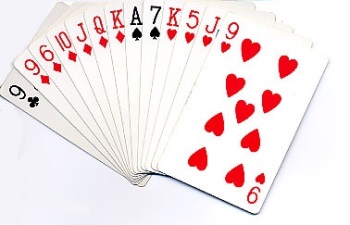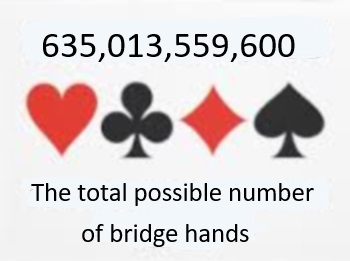
Distribution points
Counting distribution points in a bridge hand
A little digression. Before we look at distribution points it is essential that we are aware of a very important fact. When someone makes a bid, they not only state how many tricks they are going to make but also the suit they propose to use as trumps. They can also indicate that they don't want to use any trumps in which case the hand is played as a NO TRUMP game. (If you need an explanation about tricks and trumps please read this page).
For bidding purposes ONLY, the suits have values or ranking as follows:
- Lowest = Clubs
- Higher + Diamonds
- Higher still = Hearts
- Higher even still = Spades
- Highest = No Trumps
Clubs and Diamonds are known as minor suits because you need eleven tricks to make game when they are trumps.
Hearts and spades are known as major suits because you only need ten tricks to make game when they are trumps
You MUST remember the following sequence in order to bid when playing bridge.
CLUBS, DIAMONDS, HEARTS, SPADES, NO TRUMPS. (If it helps, they are in alphabetical order. i.e. C, D, H, S). Or the other way round Speed Humps Damage Cars.
 The lowest bid you can make is one club which is an undertaking to take seven tricks! Where did the other six tricks come from I hear you ask? For an answer to this please see this separate explanation although you don't need to know this to play the game. (Explanation opens in a new window).
The lowest bid you can make is one club which is an undertaking to take seven tricks! Where did the other six tricks come from I hear you ask? For an answer to this please see this separate explanation although you don't need to know this to play the game. (Explanation opens in a new window).
Because the suits have values, (known as ranking), during the bidding stage a bid of one diamond overcalls a bid of one club. One heart overcalls one diamond and one spade overcalls one heart. Top of them all is one no trump which outranks all the other bids. Similarly if someone bids, (for example), one spade, you have to bid two clubs, diamonds or hearts to overcall them. We will come back to this later but for now let's deal with distribution points.
The hand shown contains distribution points as well as High Card Points. For a singleton of a suit, in this case the club, you can generally add two points to your point count and for a doubleton such as the spades shown here you should normally add one point. For a complete void in a suit, three points can be added. Important note: You cannot count points and distribution for the same card. For example, a king on it's own is worth 3 points. You can't then argue it's also worth 2 points because it's a singleton.
These distribution points should only be used when bidding a suit. For a no trump contract, an even distribution is better. This is very important. The hand above contains 14 HCP and 3 distribution points or 17 points in total. The reason that short suits are valuable is that if the opponents choose to attack them the person playing the hand, (known as the declarer), can trump them and win the trick. It goes without saying that being short in your trump suit is a disadvantage rather than the other way around so the distribution points only apply to the suits that are NOT destined to be trumps.
 One other reason to count distribution points is where the suit has more than five cards such as the hand shown above where there are six diamonds. A further point can be added for this making the above hand with a grand total of 18 points.
One other reason to count distribution points is where the suit has more than five cards such as the hand shown above where there are six diamonds. A further point can be added for this making the above hand with a grand total of 18 points.
There is a total of 40 High Card Points in the pack, (ten in each suit) and you only have a choice of 38 legal bids to describe your hand but a total of 635,013,559,600 hand combinations are possible! It has been said that if you take a pack of cards, shuffle them and lay them down face up, you are seeing something that no human being has ever seen before in the entire history of mankind.
Don't worry, it's not that difficult!
To illustrate the importance of distribution, refer to this hand from the James Bond book, Moonraker (Opens in a new window)
Internal Website Links
- Home Page
- Weekly Results
- Bridge Etiquette
- Beginners Lessons
- Artificial Bids (Conventions)
- Slam Bidding
- English Bridge Union
- Play Bridge On Line
- Brian Bridge Scoring
Ads by Google
